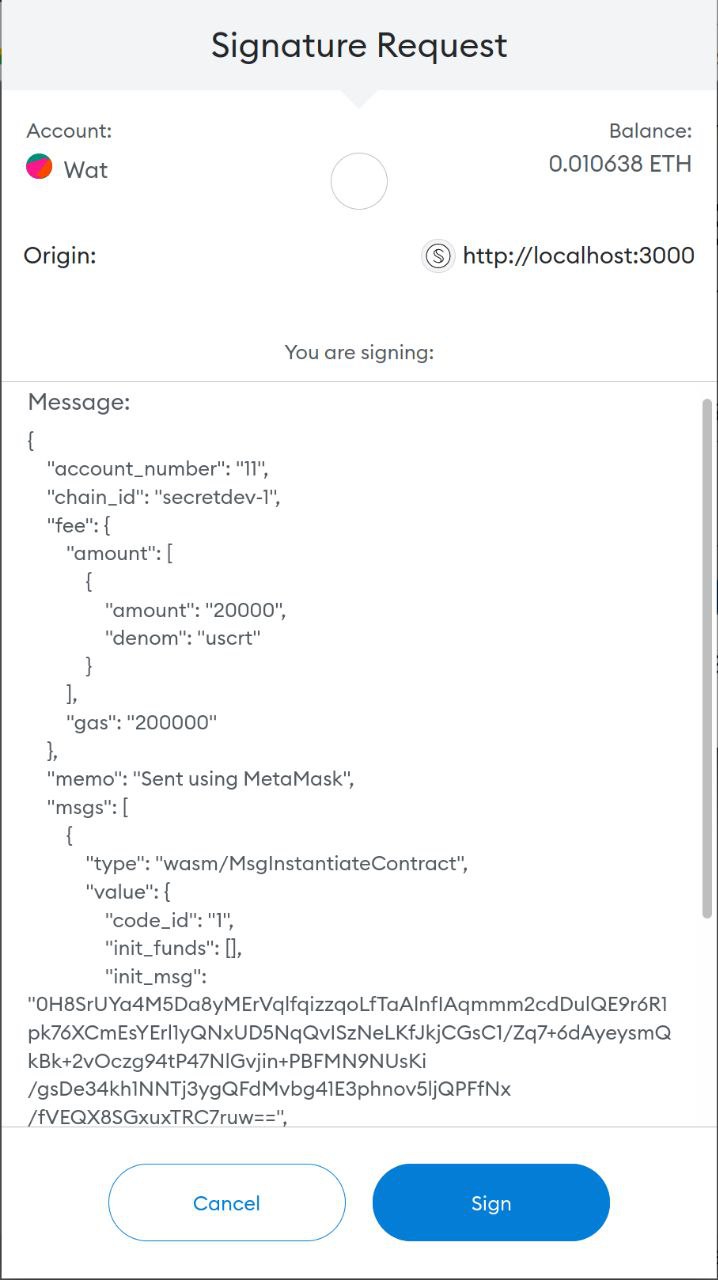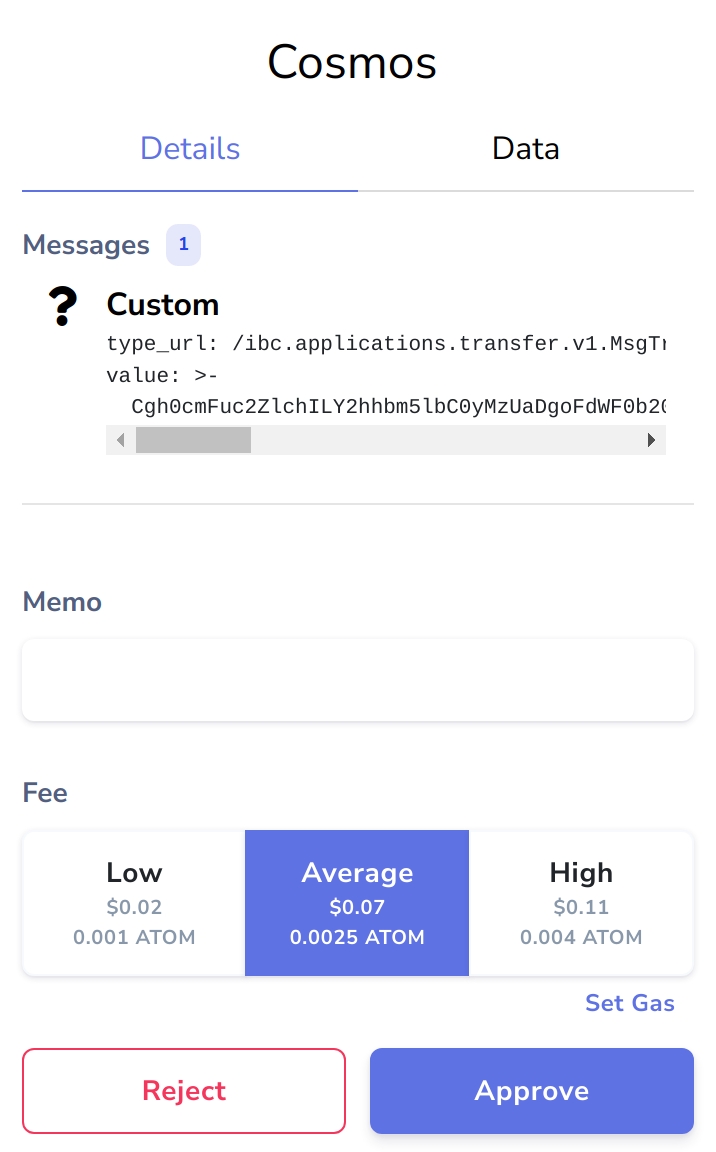Wallet Integrations
Learn how to integrate various web3 wallets with SecretJS.
Secret Network Client Setup
import { SecretNetworkClient, Wallet } from "secretjs";
const wallet = new Wallet("Your mnemonic words go here");
const secretjs = new SecretNetworkClient({
chainId: "pulsar-3",
url: "https://pulsar.lcd.secretnodes.com",
wallet: wallet,
walletAddress: wallet.address,
});Metamask
import { SecretNetworkClient, MetaMaskWallet } from "secretjs";
//@ts-ignore
const [ethAddress] = await window.ethereum.request({
method: "eth_requestAccounts",
});
const wallet = await MetaMaskWallet.create(window.ethereum, ethAddress);
const secretjs = new SecretNetworkClient({
url: "TODO get from https://github.com/scrtlabs/api-registry",
chainId: "secret-4",
wallet: wallet,
walletAddress: wallet.address,
});Notes:
MetaMask supports mobile!
MetaMask supports Ledger.
Secretjs
MetaMaskWalletwill automatically prompt the user to sign apersonal_signmessage, which is used to recover the users public key and derive the user's Secret Network address.You might want to pass
encryptionSeedtoSecretNetworkClient.create()to use the same encryption key for the user across sessions. This value should be a true random 32 byte number that is stored securly in your app, such that only the user can decrypt it. This can also be asha256(user_password)but might impair UX.See Keplr's
getOfflineSignerOnlyAmino()for list of unsupported transactions.

Keplr Wallet
The recommended way of integrating Keplr is by using window.keplr.getOfflineSigner():
Notes:
No mobile support yet.
Keplr supports Ledger.
By using
encryptionUtilsyou let Keplr handle user encryption keys for you, which allows you to easily decrypt transactions across sessions.
Links:
Signer vs SignerAuto vs SignerOnlyAmino
TLDR:
getOfflineSigner(): The recommended way. Efficient, supports all transaction types except Ledger.getOfflineSignerAuto(): Automatically selects the best signer based on the account type (Ledger or not).getOfflineSignerOnlyAmino(): The legacy way. Recommended only for Ledger users.
window.keplr.getOfflineSignerOnlyAmino()
The legacy and non-recommended way of signing transactions on cosmos-sdk. Suitable only for Ledger users due to its limited transaction support and better UI.
🟩 Looks good on Keplr
🟩 Supports users signing with Ledger
🟥 Doesn't support signing these transactions:
Every tx type under
ibc_client,ibc_connectionandibc_channel(meaning IBC relaying, for example with ts-relayer)
Note that ibc_transfer/MsgTransfer for sending funds across IBC is supported.

window.keplr.getOfflineSigner()
The recommended way of signing transactions on cosmos-sdk. Efficient and supports all transaction types except those requiring a Ledger.
🟥 Looks bad on Keplr
🟥 Doesn't support users signing with Ledger
🟩 Supports signing transactions with all types of Msgs
window.keplr.getOfflineSignerAuto()
Automatically chooses the best signing method based on the user's Keplr account:
For Ledger users, uses
window.keplr.getOfflineSignerOnlyAmino().For non-Ledger users, uses
window.keplr.getOfflineSigner().🟩 Smart and adaptable
🟩 Provides flexibility for both Ledger and non-Ledger accounts

If the connected Keplr account uses Ledger, returns window.keplr.getOfflineSignerOnlyAmino().
Otherwise returns window.keplr.getOfflineSigner().
Fina Wallet
Fina implements the Keplr API, so the above Keplr docs applies. If you support Keplr, your app will also work on the Fina Wallet mobile app. This works because the Fina Wallet mobile app has webview to which it injects its objects under window.keplr.
Fina supports deep linking into its in-app browser.
Example1: fina://wllet/dapps?network=secret-4&url=https%3A%2F%2Fdash.scrt.network
Example2:
If a user accessed your app using a regular mobile browser, you can open your app in the Fina in-app browser using this code:
Links:
Leap Cosmos Wallet
The recommended way of integrating Leap is by using window.leap.getOfflineSigner():
Links:
Starshell Wallet
StarShell implements the Keplr API, so the above Keplr docs applies. If you support Keplr, your app will also work on StarShell wallet. This works because StarShell wallet asks the user to turn off Keplr and then overrides window.keplr with its objects.
Links:
Ledger Wallet
@cosmjs/ledger-amino can be used to sign transactions with a Ledger wallet running the Cosmos app.
Notes:
Use the appropriate
hw-transportpackage for your environment (Node or Browser)The Ledger Cosmos app only supports coin type 118
You might want to pass
encryptionSeedtoSecretNetworkClient.create()to use the same encryption key for the user across sessions. This value should be a true random 32 byte number that is stored securly in your app, such that only the user can decrypt it. This can also be asha256(user_password)but might impair UX.See Keplr's
getOfflineSignerOnlyAmino()for list of unsupported transactions.
Links:
Last updated
Was this helpful?